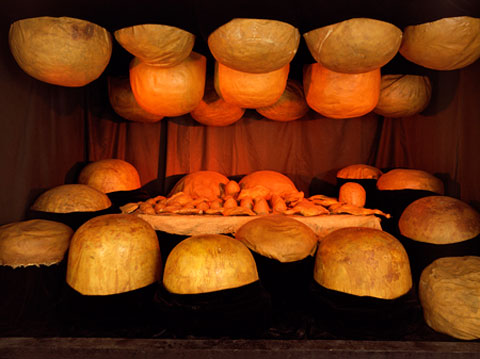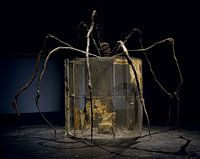Introduction
Louise Bourgeois was born on December 25, 1911 in Paris, France. She was an American citizen and an artist by profession; however, she passed on at the age of 98 years in 2010 following a heart attack (Nixon 12). Born in a financially stable family, as the second born of three children, her parents owned an antiques tapestries gallery. As a child, she often drew the missing parts of images, which assisted in repairs.
Her work has flourished since the 20th century. She was married in 1938 to Robert Goldwater, an art historian, and together, they raised three sons; however, her husband died in 1973. She studied at the University of Sorbonne, in Paris, France, where she studied mathematics and geometry; however, she later on left the university and enrolled in an art school.
After she got married, the couple moved to New York, where she enrolled at the art student league, and studied painting. Her work is well illustrated in sculptures, paintings, and drawings. In 1982 at the age of 70 years, the museum of modern art in New York brought attention to her career.
Having found effective audiences, she continuously presented her work (“Louise Bourgeois” 2). Some of her famous art included the velvet eyes, which includes “two large, staring, bird-like eyes locked in eternal gaze from the depths of a rough-edged rock” (Newsmakers 2). Another art is that of a headless rabbit with breasts vertically. Needless to say, her art was stylish and emotionally aggressive, as well as displayed forms of sexual explicit.
In 1994 exhibition, Louise created a locus of memory, whereby, a single sculpture with variety of drawings, and a center image of a spider represented a woman of changing moods (Nixon 45).
In spite of starting her exhibition career in the 30s, her career began to mature in the 50s when she was introduced to successful artists such as Willem de Kooning and Louise Clement. Louise Bourgeois remains one of the famous women artists to date; most of her work is based on domestic confinement and comfort, where feminine is presented by vulnerability, strength, and complicity.
The work of Louise Bourgeois compared to other artists
Louise Bourgeois’ work was competitive; the stylish, emotional, and creative art stood out from the rest. The artist revealed emotions and tragedies in her art. In 1992, she was the only second woman to be honored at the Venice Binnale, where she represented America (“Louise Bourgeois” 4). Unlike other artists like Lucian Freud, who concentrated on painting alone, Louise Bourgeois expanded her horizons to sculptures as well as drawings and paintings.
The art industry was competitive, with the existence of several talented artists; Lucian Freud was among them, and among his significant painting is the ‘naked man with a rat’, of 1977-78. Though controversial, his painting gained more fame. However, Freud passed on in July 2011; nevertheless, he is known as a figurative artist of the 20th century.
Louise Bourgeois was not limited to any materials; she used wood to curve sculptures, and also painted and drew images that were motivated by her emotions. Willem de Kooning was another artist who was born in 1904; he mainly engaged in painting and resided in New York just like Louise Bourgeois.
His painting was mostly based on expressionism, and his paintings are legendary; however, unlike Louise, Willem specialized in painting alone. According to Hess and Kooning (7), Willem was dedicated to art and painting, qualities that were expressed in his paintings.
Louise’s artwork gained fame due to its uniqueness and diversity, varying from sculpture work, painting to drawing. For instance, one of her major works included ‘destruction of the father’ in 1974, which include cave-like structures shaped like rocks in a sacrificial slab. This was a disturbing piece of work, describing a tearing family due to the war in Vietnam, which left many soldiers dead.

Needless to say, Louise’s work has continued to flourish, and has no limits in expressing emotions. While dealing with feminine issues, Louise is not limited, as she expresses both the female body and sexuality. Her work also consists of style and a subject matter; unlike her fellow artists, she challenges the traditional concepts of women and the masculine stereotypes. It is also evident that Louise art includes several materials ranging from wood to steel. Therefore, she took pleasure in selecting her art materials. Louise has surpassed the status of a highly significant and intelligent woman.
She was and still is one of the most influential and challenging artists. According to Potts (17), Louise’s artwork especially sculptures are visible, which allows audiences to get the picture and the themes of the art. Louise can be differentiated from her fellow artists through her unique incorporation of art materials, which yields to an outstanding artwork.
An example of the Louise Bourgeois’s work

The spider sculpture symbolizes Louise Bourgeois’s mother who was her best friend, and was protective like the spiders; she was also a weaver just like the spiders. Therefore, Louise’s artwork is influenced by emotions, which makes her art unique (catton 16). This image is made of steel, wood, fabric, silver, gold, bone, and tapestry, and as a result, her artwork was not limited to one component.
It signifies maternal protection. The huge legs are for a child’s support, whereby, he can cling to the legs and feel secure. According to Bal (184), Louise’s work consists of narratives, especially in the spider sculpture, offering a view of how dreams can be constructed uniquely.
However, her work has faced numerous critics, among them being the fact that the spider sculpture lacks a narrative that fulfills its story (Bal 191). Nevertheless, other critics view Louise more of a surrealist compared to an artist; this is as a result of her subversive art. The spider web is both a home and a weapon as well, symbolizing trappings of domesticity.
In addition, her works symbolize both post modernist and modernist eras. Needless to say, other critics arise from the fact that a spider is viewed as a threatening symbol; however, audiences of this sculpture art find it humorous, mysterious, and comforting.
Another criticism is the artist’s symbolization of her mother as a spider, which is big and dangerous, as opposed to a mother who is humble and caring. This argument challenges the context of the sculpture. The childhood experiences and emotions are present in her artwork. Her experience with a calm, collective, and affectionate mother who was considered as an invalid, and her domineering father who was unfaithful are evident in her art.
Catton (15) insists that Louise’s creativity is evident in the way she sews together her memories, emotions, and experiences to an art. In addition, Louise’s art signifies creativity and self-sustaining, and the artist did not imitate anyone – she outlaid vision and the importance of art, however simple or complicated it may be. According to Potts (37), Louise always insisted that art is not related to the artist; however, art should always be independent.
Conclusion
Louise Bourgeois is a legend in the field of art; despite her death, her works continue to inspire and motivate fellow artists. Throughout her career, she has been one of the most successful women in the industry. Despite numerous critics concerning her artwork, she is praised for her maximization of art materials, as she is not limited to a specific material, with her artwork comprising of wood, steel, and fabric among other components.
Another admirable factor is the emotions expressed in her artwork; she is among the few artists who put her emotions into her work. Her spider sculpture symbolizes her mother, who is seen as caring and protective, while the destruction of a father sculpture signifies a tearing family. All her art ideas are drawn from experiences and emotions, and most of them aim at promoting equality and discouraging masculine stereotype.
In addition, Louise’s artwork is unique in that, she is diverse and can create art through painting, drawing or making sculptures, an aspect that is rare. This is because most artists concentrate on one field; for instance, Willem Freud concentrated on painting alone. Louise Bourgeois’ artwork attempts to capture the audiences’ thoughts by creating quality in her works. In spite of her death and critics surrounding her work, she remains a legend.
Works Cited
Bal, Mieke. “Autotopography: Louise bourgeois as builder.” Biography: An Interdisciplinary Quarterly 25.1 (2002): 180. Web.
Catton, Pia. “Louise Bourgeois Dies at 98.” New York Cultures, 20.1 (2010): 15-16. Web.
Centre Pompidou. Louise Bourgeois: A landmark exhibition. 2008. Web.
Hess, Barbara and W. Kooning. Willem de Kooning, 1904-1997: content as a glimpse. NY: Taschen Publisher, 2004. Web.
“Louise Bourgeois.” Newsmakers. Detroit: Gale, 1994.
Nixon, Mignon. Fantastic Reality: Louise Bourgeois and a Story of Modern Art. NY: Taschen Publisher, 2010. Web.
Potts, Alex. “Louise Bourgeois – Sculptural confrontations.” Oxford art journal, 22.2 (1999): 37-53. Web.
Stuart, Paul. Sculptor Louise Bourgeois: A year of events celebrating her life and work. 2009. Web.